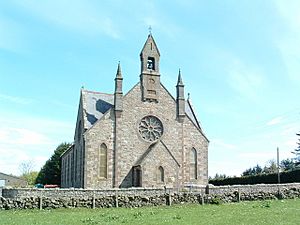Cookney Church facts for kids
Cookney Parish Church was once a Christian church in the village of Cookney, Aberdeenshire, Scotland. Today, it is a listed building that has been changed into a place for a business. A listed building is a special building that is protected because of its history or unique design.
Where is Cookney Church?
Cookney Church sits on top of a tall hill. You can see it from far away! Because it's so high up, people sometimes use it to compare heights. For example, a group once said that new wind turbines would be "five times the height of the Cookney Church." This helps people imagine how tall the turbines would be.
Other important old buildings nearby include Elsick House and the Lairhillock Inn.
History of Cookney Church
The building you see today was built in 1885. However, the very first Cookney Church was started on this same spot much earlier, in 1816.
The National Library of Scotland has a special coin-like item called a communion token from 1859. This token is considered an important historical item from that year in Scotland.
There's a long history of Episcopal churches in this area. Some of the earliest churches were connected to nearby Muchalls Castle. In the early 1600s, an Episcopal church was even built inside Muchalls Castle itself! There are also older, ruined Episcopal churches a little to the east, on land that once belonged to Muchalls Castle.
Cookney Church is located a bit to the west, on a high hill. From there, you can see an ancient path called the Causey Mounth. This old path was built a long time ago, in the medieval period. It was the only way to cross the Grampian Mounth along the coast. This path connected places south of Stonehaven to Aberdeen. It was a special drovers' road, which means it was used by people moving animals. It linked the River Dee (where the Bridge of Dee is now) to Muchalls Castle and Stonehaven.
An important event happened on this path in 1639. William Keith, 7th Earl Marischal and the Marquess of Montrose led an army of 9,000 men along this route. This was during the first battle of the Civil War.
Today, the old Cookney Church building is used as a business office for a company called RUM Consultancy.
More to Explore
- Netherley
- Red Moss


